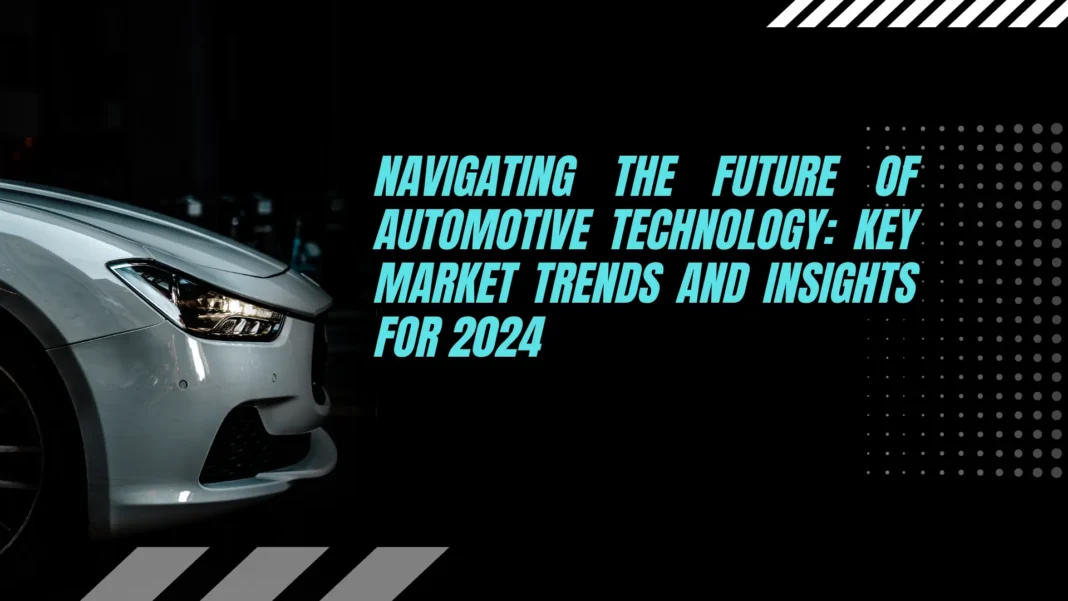Introduction
The automotive industry is undergoing a significant transformation, fueled by advancements in technology, changing consumer demands, and regulatory pressures. Auto tech innovations are reshaping how vehicles are designed, manufactured, and used, from autonomous driving and electric vehicles (EVs) to smart infrastructure and connectivity. This blog will explore the latest market trends in auto tech, offering insights into key developments, growth opportunities, and challenges that businesses and consumers should watch for in 2024 and beyond.
1. Growth of Electric Vehicles (EVs) and Charging Infrastructure
The global shift toward sustainability is one of the driving forces behind the rapid adoption of electric vehicles (EVs). In 2024, the EV market is expected to continue expanding, driven by advancements in battery technology, government incentives, and consumer demand for cleaner alternatives to internal combustion engines.
Key Insights:
- Battery Technology Advancements: How improvements in lithium-ion batteries are reducing costs and increasing the range of EVs.
- EV Charging Infrastructure: The rise in public and private charging stations, and how the expansion of charging networks will impact EV adoption.
- Market Segmentation: A look at different EV market segments, from luxury to budget-friendly models, and the shift toward mass-market adoption.
Example: The growing role of fast-charging networks in reducing EV “range anxiety,” making EV ownership more practical.
2. The Rise of Autonomous Vehicles (AVs): Challenges and Opportunities
Autonomous vehicles (AVs) are poised to change the way we think about transportation, with companies investing heavily in self-driving technology. However, despite significant technological advancements, regulatory and safety hurdles remain a challenge for the widespread deployment of AVs.
Key Trends:
- Tech Developments: The integration of sensors, AI, and machine learning in self-driving vehicles.
- Testing and Regulations: How governments are regulating AV testing and implementation.
- Consumer Adoption: Understanding public trust in AVs and how companies are addressing safety concerns.
Example: The testing of autonomous taxis in select cities, and how these tests could shape the future of urban mobility.
3. Connected Vehicles and the Internet of Things (IoT) in Auto Tech
Connected vehicles are now a standard feature in modern automobiles, allowing for advanced infotainment systems, vehicle-to-vehicle (V2V) communication, and real-time data analysis. The integration of IoT technologies is enhancing safety, convenience, and the overall driving experience.
Key Technologies:
- Vehicle-to-Everything (V2X) Communication: How V2X technology is enabling smart city infrastructure and improving traffic management.
- Telematics and Fleet Management: The role of IoT in monitoring vehicle health, tracking performance, and improving fleet management.
- Cybersecurity Concerns: With more connectivity comes greater risk; how auto tech companies are addressing cybersecurity in connected vehicles.
Example: The use of connected vehicle technology for predictive maintenance, reducing downtime for fleet operators.
4. Automotive Software and Over-the-Air (OTA) Updates
As vehicles become more software-dependent, over-the-air (OTA) updates are becoming a key feature in the automotive market. Car manufacturers are now able to remotely update vehicle systems, improving performance, security, and even adding new features after the vehicle has been sold.
Key Points:
- Benefits of OTA Updates: Lower maintenance costs, improved customer satisfaction, and keeping vehicles up-to-date with the latest features.
- Challenges in Implementation: The complexities of ensuring security and compliance with evolving standards.
- Automakers Leading the Charge: Companies like Tesla and others pioneering the use of OTA updates in vehicles.
Example: How a major automaker pushed an OTA update to enhance the performance of electric cars, offering customers an improved driving experience.
5. The Future of Mobility: Shared and Subscription-Based Services
The growing interest in mobility-as-a-service (MaaS) is changing how people access vehicles. With subscription models and shared mobility options, consumers now have greater flexibility when it comes to transportation.
Key Insights:
- Car Subscription Services: How carmakers are offering subscription models to provide access to a variety of vehicles for a fixed monthly fee.
- Shared Mobility Solutions: The rise of ride-hailing and car-sharing services, and how they are impacting vehicle ownership trends.
- Environmental Impact: The role of shared mobility in reducing carbon footprints and addressing urban congestion.
Example: A look at how companies like Uber and Lyft are partnering with automakers to offer more sustainable transportation options in cities.
6. Sustainability and the Role of Green Technologies in Auto Manufacturing
Sustainability is becoming a central focus for auto manufacturers as the industry faces pressure to reduce its environmental impact. From eco-friendly materials to sustainable manufacturing practices, the move toward a greener automotive industry is reshaping product development.
Sustainable Innovations:
- Eco-Friendly Materials: The use of recyclable and renewable materials in vehicle construction.
- Green Manufacturing: How manufacturers are adopting energy-efficient and low-emission processes.
- Recycling and Battery Disposal: Addressing concerns over the lifecycle of EV batteries and implementing sustainable recycling programs.
Example: Automakers introducing biodegradable car components and more energy-efficient manufacturing processes to meet sustainability targets.
7. Impact of Global Supply Chain Challenges on Auto Tech Innovations
Global supply chain disruptions have impacted the automotive sector, affecting everything from chip shortages to delays in manufacturing. As the industry adapts, these challenges are shaping the future of automotive tech innovation.
Key Areas of Impact:
- Chip Shortages: The ongoing semiconductor supply chain issues and their impact on vehicle production.
- Supply Chain Diversification: How automakers are adapting to mitigate future disruptions by diversifying supply sources.
- Accelerating Innovation: How the challenges are pushing the industry to innovate faster, from automated production lines to blockchain supply chain solutions.
Example: A look at how semiconductor shortages are forcing automakers to rethink production strategies and accelerate tech developments.
Conclusion
The automotive technology market is experiencing rapid growth and innovation. As we move into 2024, advancements in electric vehicles, autonomous driving, connected car technology, and more are set to transform the industry. For businesses and consumers, staying informed on these trends will be crucial for navigating the evolving landscape of automotive tech. By focusing on data-driven strategies and embracing new technologies, companies can capitalize on opportunities and drive growth in this dynamic market.

